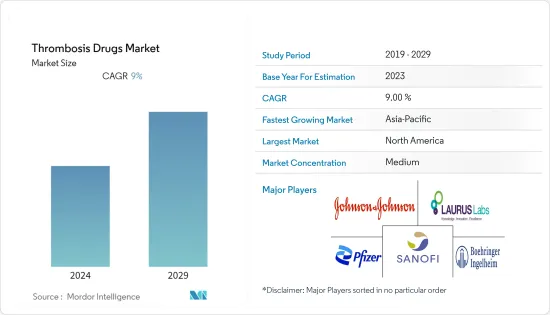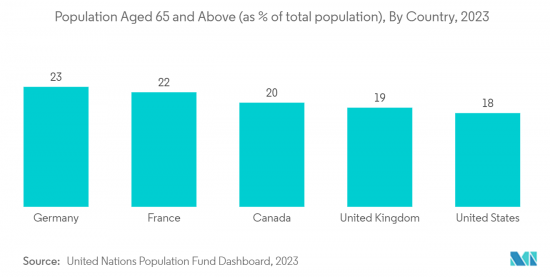
|
市場調査レポート
商品コード
1404431
血栓症治療薬:市場シェア分析、産業動向と統計、2024~2029年の成長予測Thrombosis Drugs - Market Share Analysis, Industry Trends & Statistics, Growth Forecasts 2024 - 2029 |
||||||
カスタマイズ可能
適宜更新あり
|
|||||||
| 血栓症治療薬:市場シェア分析、産業動向と統計、2024~2029年の成長予測 |
|
出版日: 2024年01月04日
発行: Mordor Intelligence
ページ情報: 英文 130 Pages
納期: 2~3営業日
|
全表示
- 概要
- 目次
血栓症治療薬市場は予測期間中に約9.0%のCAGRで推移すると予想されます。
COVID-19の大流行は、調査した市場の成長に大きな影響を与えました。例えば、2021年の世界保健機関(WHO)によると、初期のパンデミックの間に調査された国の半数以上で、心血管危機に対するサービスが部分的または全面的に中断されました。さらに、2021年12月にBritish Medical Journal誌に発表された研究によると、COVID-19患者では抗血小板療法(APT)が死亡率の低下に役立つ可能性があります。無作為化実験(RECOVERY)では、アスピリン療法が生存率の1.2%の絶対的上昇につながることが判明しました。このように、COVID-19の大流行は市場の成長に大きな影響を与えました。しかし、パンデミックは現在沈静化しているため、本調査の予測期間中、市場はパンデミック以前の成長レベルを経験すると予想されます。
市場の主要原動力は、高齢者人口や肥満人口の増加、心血管疾患や外傷の負担増、血液学の技術進歩です。例えば、国連のWorld Population Prospects 2022によると、65歳以上の世界人口に占める割合は、現在の10%から27年には16%に上昇すると予測されています。また、2050年までに、世界の65歳以上の人口は5歳以下の子供の2倍以上、12歳以下の子供とほぼ同数になると予測されています。高齢者はこの病気にかかりやすいため、治療薬に対するニーズが高まり、市場の成長が促進されると予想されます。
さらに、肥満の負担が増加していることも、ここ10年で世界的に大きく変化しています。新興国市場も先進国市場も、関連疾患のコントロールに大きな問題を抱えています。過体重や肥満に伴うアルコールやタバコの消費量の増加は、長期間にわたって静脈に著しい血圧を発生させ、いくつかの血栓症関連合併症を引き起こす高いリスクを付加するため、この市場を牽引しています。例えば、2022年3月の世界保健機関(WHO)の報告によると、2022年には世界全体で、6億5,000万人の成人、3億4,000万人のティーンエイジャー、3,900万人の子どもを含む10億人以上が肥満です。さらに、1億6,700万人の大人と子どもが、太りすぎや肥満が原因で2年後の健康状態が悪化すると予想されています。このように、肥満人口の増加に伴い、肥満は血管疾患の重大な原因であるため、血栓治療薬の需要は予測期間中に増加すると予想されます。その他、心血管疾患や外傷の負担が増加していること、血液疾患分野の研究開発費が増加していることも、この市場の成長に寄与しています。
しかし、静脈血栓塞栓症の病態や血栓症治療薬に伴う副作用に対する認識不足が、予測期間中の市場成長を抑制する可能性があります。
血栓症治療薬の市場動向
深部静脈血栓症(DVT)セグメントは予測期間中に大幅な成長が見込まれる

深部静脈血栓症(DVT)は、脚から血液を送り出す太く深い静脈のいずれかに血栓ができる疾患で、腕や心臓に血栓ができることは稀です。慢性深部静脈血栓症の有病率の増加と主要市場参入企業による製品投入が、本セグメントの成長を牽引しています。加えて、低コストの薬剤開発に注力する傾向が強まっていること、患者数が多いことも血栓症治療薬市場の成長に寄与しています。
2021年8月にNational Library of Medicineに掲載された研究によると、下肢のDVT有病率は毎年1,000人当たり1人であり、DVTの年間発生率は10万人当たり80件と予測されています。さらに、同出典によると、米国では年間20万人以上が静脈血栓症を経験しており、このうち5万例は肺塞栓症によって悪化しています。このように、深部静脈血栓症の有病率の増加は、予測期間中のセグメントの成長を促進すると予想されます。
さらに、市場参入企業は革新的な製品の導入に注力しており、市場成長にさらに拍車をかけています。例えば、米国食品医薬品局は2021年6月、生後3カ月から12歳以下の小児の深部静脈血栓症(DVT)と肺塞栓症(PE)の治療にプラザキサ(ダビガトランエテキシラート)経口ペレットを承認しました。さらに、DVTは高齢と関連することが多く、これもセグメントの成長を高めると予想されます。
このように、DVTの高い有病率や製品発売の増加など、上記のすべての要因が予測期間中の市場成長を後押しすると予想されます。

予測期間中、北米が市場で大きなシェアを占める見込み
北米は、心血管疾患や肥満の蔓延、先進的な治療オプションに対する需要の急増、新技術の早期導入、高齢者人口の増加などにより、市場で大きなシェアを占めると予想されます。加えて、多様な患者層の存在や、これらの地域におけるキャンペーンへの国内外の企業の参加増加も、市場成長に寄与すると予測されています。
例えば、Trust for America's Health(TFAH)が2022年9月に更新したデータによると、米国では2022年に推定19州で肥満率が35%を超え、2021年の16州から増加しました。これは同地域の市場成長にプラスの影響を与えそうです。
さらに、心血管疾患にかかりやすい高齢者人口が増加していることも、市場成長を押し上げると予想されます。例えば、2021年に発表されたAmerica's Health Rankings Senior Reportによると、米国に住む高齢者の数はかなりの数に上り、増加傾向にあります。27年には65歳以上の成人が8,570万人になると予測されています。このような高い疾患罹患率と高齢化により、先進的な治療に対する需要が高まり、市場の成長に寄与する可能性が高いです。
さらに、カナダ健康情報研究所が2022年7月に更新したデータによると、今年度のカナダ人の心臓病罹患者数は約240万人と推定されています。このように、国全体で心血管疾患の負担が増加しており、治療のための血栓症治療薬の使用量の増加につながるため、調査された市場は力強い成長を示すと予想されます。
このように、心血管疾患の高い有病率や高齢者人口の増加など、前述のすべての要因が予測期間中の市場成長を後押しすると予想されます。
血栓症治療薬産業概要
血栓症治療薬市場は適度に統合されており、市場に参入している世界参入企業は少数です。例えば、Bayer AG、Boehringer Ingelheim GmbH、Bristol-Myers Squibb、Johnson &Johnson、Sanofi、Pfizer, Incなどが世界中でこれらの製品を提供しています。主要企業は、新製品発売や買収など様々な戦略を通じて進化し、世界の競争市場での地位を確保しています。
その他の特典
- エクセル形式の市場予測(ME)シート
- 3ヶ月間のアナリストサポート
目次
第1章 イントロダクション
- 調査の前提条件と市場定義
- 調査範囲
第2章 調査手法
第3章 エグゼクティブサマリー
第4章 市場力学
- 市場概要
- 市場促進要因
- 高齢者人口と肥満人口の増加
- 心血管疾患と外傷の増加
- 血液検査における技術進歩の増加
- 市場抑制要因
- 静脈血栓塞栓症に対する認識不足
- 血栓塞栓症治療薬が引き起こす副作用
- ポーターのファイブフォース分析
- 供給企業の交渉力
- 買い手/消費者の交渉力
- 新規参入業者の脅威
- 代替品の脅威
- 競争企業間の敵対関係の強さ
第5章 市場セグメンテーション(市場規模-米ドル)
- 薬剤クラス別
- 第Xa因子阻害薬
- ヘパリン
- P2Y12血小板阻害薬
- その他の薬剤クラス別
- 疾患タイプ別
- 肺塞栓症
- 心房細動
- 深部静脈血栓症
- その他の疾患タイプ
- 流通チャネル別
- 病院薬局
- 小売薬局
- オンライン薬局
- 地域別
- 北米
- 米国
- カナダ
- メキシコ
- 欧州
- ドイツ
- 英国
- フランス
- イタリア
- スペイン
- その他の欧州
- アジア太平洋
- 中国
- 日本
- インド
- オーストラリア
- 韓国
- その他のアジア太平洋
- 中東・アフリカ
- GCC諸国
- 南アフリカ
- その他の中東とアフリカ
- 南米
- ブラジル
- アルゼンチン
- その他の南米
- 北米
第6章 競合情勢
- 企業プロファイル
- Laurus Lab(Aspen Pharmacare Holdings Limited)
- AstraZeneca PLC
- Bayer AG
- Boehringer Ingelheim GmbH
- Bristol-Myers Squibb
- Johnson & Johnson
- Pfizer Inc.
- Sanofi SA
- Teva Pharmaceutical Industries Ltd
- Swiss Pharma Pvt Ltd
第7章 市場機会と今後の動向

The thrombosis drugs market is expected to register a CAGR of about 9.0% over the forecast period.
The COVID-19 pandemic had a significant impact on the studied market growth. For instance, according to the World Health Organization, 2021, services for cardiovascular crises have been interrupted partially or entirely in more than half of the nations examined during the early pandemic. Furthermore, according to the study published in the British Medical Journal in December 2021, in individuals with COVID-19, antiplatelet therapy (APT) may help reduce mortality; a randomized experiment (RECOVERY) found that aspirin therapy is linked to a 1.2% absolute gain in survival. Thus, the COVID-19 outbreak affected the market's growth significantly; however, as the pandemic has currently subsided, the market is expected to experience pre-pandemic growth levels during the study's forecast period.
The market is primarily driven by the increase in the geriatric and obese population, the rising burden of cardiovascular diseases and trauma cases, and the technological advancement in haematology. For instance, according to the United Nations World Population Prospects 2022, the share of the global population aged 65 years or above is projected to rise from 10 per cent in the current year to 16 per cent in 27 years. The source also stated that by 2050, the number of persons aged 65 years or over worldwide is projected to be more than twice the number of children under age five and about the same as that of children under age 12. Since the older population is prone to the disease, it is expected to generate the need for these drugs for treatment, thereby driving the market's growth.
Additionally, the increasing burden of obesity has also changed significantly in the last decade globally. Developed and emerging markets are having significant issues controlling the associated diseases. The growing consumption of alcohol and tobacco, with overweight and obesity, adds a high risk of developing significant blood pressure in veins for a long period of life, leading to several thrombosis-related complications, thus driving this market. For instance, according to the World Health Organization Report of March 2022, globally, over 1 billion individuals, including 650 million adults, 340 million teenagers, and 39 million children, were obese in 2022. Additionally, 167 million adults and children are expected to have worse health in two years due to being overweight or obese. Thus, with the increase in the obese population, the demand for thrombotic drugs is expected to increase over the forecast period as obesity is a significant cause of vascular diseases. Other factors contributing to the growth of this market are increasing the burden of cardiovascular and trauma cases, and the increasing research and development expenditure in the field of hematological disorders.
However, a lack of awareness about venous thromboembolism conditions and the side effect associated with thrombosis drugs may restrain the market growth over the forecast period.
Thrombosis Drugs Market Trends
Deep Vein Thrombosis (DVT) Segment is Expected to Register a Significant Growth during the Forecast Period
Deep vein thrombosis (DVT) is a blood clot in one of the large, deep veins that returns blood from the leg and rarely in the arm or heart. The Segment growth is driven by the increasing prevalence of chronic deep vein thrombosis and product launches by the key market players. In addition, increasing focus on developing low-cost drugs and a large patient pool contribute to the growth of the thrombosis drugs market.
According to a study published in the National Library of Medicine in August 2021, the prevalence of DVT in lower limbs is 1 per 1000 persons every year, with an annual incidence of DVT predicted to be 80 cases per 100,000 people. Additionally, per the same source, more than 200,000 people in the United States experience venous thrombosis yearly; 50,000 of these instances are exacerbated by pulmonary embolism. Thus, the growing prevalence of deep vein thrombosis is expected to drive segment growth over the forecast period.
Furthermore, the market players are focusing on introducing innovative products, further adding to the market growth. For instance, in June 2021, the United States Food and Drug Administration approved Pradaxa (dabigatran etexilate) oral pellets to treat deep vein thrombosis (DVT) and pulmonary embolism (PE) in children aged three months to under twelve. Moreover, DVT is often associated with old age, which is also expected to enhance the segment growth.
Thus, all factors above, such as the high prevalence of DVT and increasing product launches, are expected to boost the market growth over the forecast period.

North America is Expected to Hold a Significant Share in the Market Over the Forecast Period
North America is expected to hold a significant share of the market owing to the prevalence of cardiovascular diseases and obesity, the upsurge in demand for progressive treatment options, the early adoption of new technologies, and an increase in the elderly population. Besides, the presence of a diverse patient pool and the increase in participation of domestic and foreign companies in the campaign in these regions is also projected to contribute to the market growth.
For instance, as per the data updated by the Trust for America's Health (TFAH) in September 2022, an estimated 19 states in the United States had obesity rates over 35% in 2022, which increased from 16 states in 2021. This is likely to impact the market growth in the region positively.
Additionally, a growing geriatric population that is more prone to cardiovascular diseases is expected to boost market growth. For instance, according to America's Health Rankings Senior Report published in 2021, the number of older adults living in the United States is significant and growing. Itt is anticipated that there will be 85.7 million adults in the country who are 65 years or older, in 27 years. Such a high disease prevalence, along with the aging population, is likely to increase the demand for advanced therapies, thereby contributing to market growth.
Moreover, according to the data updated by the Canadian Institute for Health Information in July 2022, it was estimated that about 2.4 million Canadians had heart disease in the current year. Thus, with the increasing burden of cardiovascular diseases across the country, the studied market is expected to witness strong growth, as it would lead to increased usage of thrombosis drugs for treatment.
Thus, all aforementioned factors such as the high prevalence of cardiovascular diseases and the growing geriatric population are expected to boost the market growth over the forecast period.
Thrombosis Drugs Industry Overview
The thrombosis drugs market is moderately consolidated, and few global players are in the market. For instance, Bayer AG, Boehringer Ingelheim GmbH, Bristol-Myers Squibb, Johnson & Johnson, Sanofi, Pfizer, Inc., etc. are providing these products across the world. The key players are evolving through various strategies, such as new product launches and acquisitions, to secure their positions in the global competitive market.
Additional Benefits:
- The market estimate (ME) sheet in Excel format
- 3 months of analyst support
TABLE OF CONTENTS
1 INTRODUCTION
- 1.1 Study Assumptions and Market Definition
- 1.2 Scope of the Study
2 RESEARCH METHODOLOGY
3 EXECUTIVE SUMMARY
4 MARKET DYNAMICS
- 4.1 Market Overview
- 4.2 Market Drivers
- 4.2.1 Growing Geriatric and Obese Population
- 4.2.2 Increasing Burden of Cardiovascular and Trauma Cases
- 4.2.3 Increasing Technological Advancements in Hematology
- 4.3 Market Restraints
- 4.3.1 Lack of Awareness about Venous Thromboembolism Conditions
- 4.3.2 Side Effects Caused, due to Thrombosis Drugs
- 4.4 Porter's Five Forces Analysis
- 4.4.1 Bargaining Power of Suppliers
- 4.4.2 Bargaining Power of Buyers/Consumers
- 4.4.3 Threat of New Entrants
- 4.4.4 Threat of Substitute Products
- 4.4.5 Intensity of Competitive Rivalry
5 MARKET SEGMENTATION (Market Size by Value - USD)
- 5.1 By Drug Class
- 5.1.1 Factor Xa Inhibitor
- 5.1.2 Heparin
- 5.1.3 P2Y12 Platelet Inhibitor
- 5.1.4 Other Drug Classes
- 5.2 By Disease Type
- 5.2.1 Pulmonary Embolism
- 5.2.2 Atrial Fibrillation
- 5.2.3 Deep Vein Thrombosis
- 5.2.4 Other Disease Types
- 5.3 By Distribution Channel
- 5.3.1 Hospital Pharmacies
- 5.3.2 Retail Pharmacies
- 5.3.3 Online Pharmacies
- 5.4 Geography
- 5.4.1 North America
- 5.4.1.1 United States
- 5.4.1.2 Canada
- 5.4.1.3 Mexico
- 5.4.2 Europe
- 5.4.2.1 Germany
- 5.4.2.2 United Kingdom
- 5.4.2.3 France
- 5.4.2.4 Italy
- 5.4.2.5 Spain
- 5.4.2.6 Rest of Europe
- 5.4.3 Asia-Pacific
- 5.4.3.1 China
- 5.4.3.2 Japan
- 5.4.3.3 India
- 5.4.3.4 Australia
- 5.4.3.5 South Korea
- 5.4.3.6 Rest of Asia-Pacific
- 5.4.4 Middle East and Africa
- 5.4.4.1 GCC
- 5.4.4.2 South Africa
- 5.4.4.3 Rest of Middle East and Africa
- 5.4.5 South America
- 5.4.5.1 Brazil
- 5.4.5.2 Argentina
- 5.4.5.3 Rest of South America
- 5.4.1 North America
6 COMPETITIVE LANDSCAPE
- 6.1 Company Profiles
- 6.1.1 Laurus Lab (Aspen Pharmacare Holdings Limited)
- 6.1.2 AstraZeneca PLC
- 6.1.3 Bayer AG
- 6.1.4 Boehringer Ingelheim GmbH
- 6.1.5 Bristol-Myers Squibb
- 6.1.6 Johnson & Johnson
- 6.1.7 Pfizer Inc.
- 6.1.8 Sanofi SA
- 6.1.9 Teva Pharmaceutical Industries Ltd
- 6.1.10 Swiss Pharma Pvt Ltd


